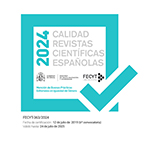De Artemisa a Artemisia. Representaciones de la amazona poderosa
Resumen
En las siguientes páginas se explora la representación de la mujer fuerte en el arte, quien, con actitud agresiva y armada, no duda en enfrentarse al hombre. Para establecer unos límites cronológicos y geográficos que acoten el estudio, se parte de la antigüedad grecorromana, pasando por la Edad Media, hasta llegar a la famosa obra de Judit y Holofernes de Artemisia Gentileschi. Se presenta, pues, un recorrido con distintos ejemplos que ilustran y configuran el discurso dentro de Europa occidental. Se pretende, por un lado, recoger las distintas mujeres —y también personificaciones con un fuerte carácter alegórico— que han sido figuradas como una femme forte, destacando sus atributos bélicos y poderosos. Por otro lado, en el recorrido también se establecen las variaciones y constantes de esta iconografía entre las distintas épocas, su vínculo con las fuentes textuales y la relación con la sociedad y el contexto del momento.
Descargas
Descarga artículo
Licencia
La revista Investigaciones Feministas, para fomentar el intercambio global del conocimiento, facilita el acceso sin restricciones a sus contenidos desde el momento de su publicación en la presente edición electrónica, y por eso es una revista de acceso abierto. Los originales publicados en esta revista son propiedad de la Universidad Complutense de Madrid y es obligatorio citar su procedencia en cualquier reproducción total o parcial. Todos los contenidos se distribuyen bajo una licencia de uso y distribución Creative Commons Reconocimiento 4.0 (CC BY 4.0). Esta circunstancia ha de hacerse constar expresamente de esta forma cuando sea necesario. Puede consultar la versión informativa y el texto legal de la licencia.











